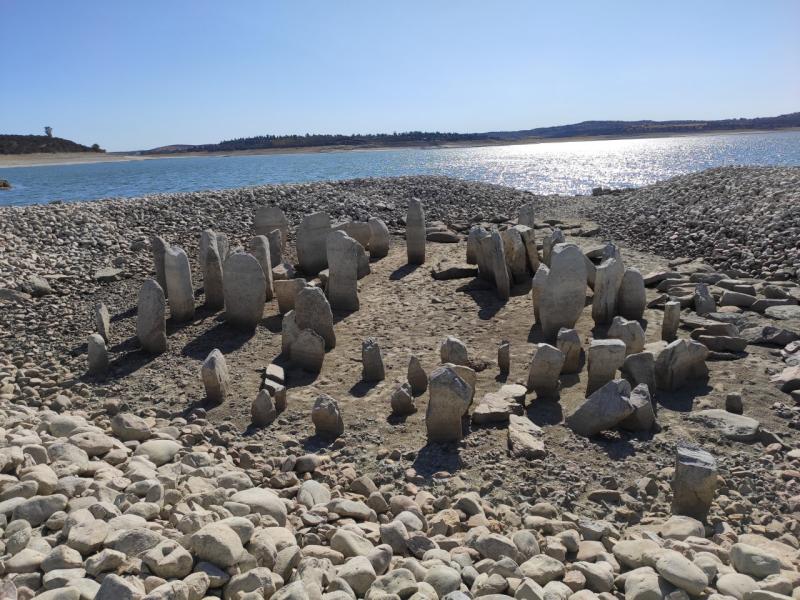Drought exposes long-submerged 'Spanish Stonehenge' monument



A 7,000-year-old monument dubbed “Spanish Stonehenge” has been exposed for the first time in 50 years, after drought conditions in western Spain dropped water levels in a manmade lake and revealed the ancient standing stones.
The circle of more than 100 large rocks, known as the Dolmen of Guadalperal, was submerged in 1963 after the Spanish government constructed the Valdecañas Reservoir to feed a hydroelectric dam that still generates power in the region. Occasionally, the tips of the tallest standing stones have been visible as the reservoir’s water levels have changed, but according to NASA, this is the first time that the entire monument has been out of water since the area was flooded to create the lake.
Water levels in the reservoir dropped significantly this summer after two intense heatwaves baked much of Europe. In Spain, June’s hot spell saw seven weather stations record their highest temperatures ever, according to the country’s meteorological agency, with several cities exceeding 104 degrees Fahrenheit (40 degrees Celsius). Higher-than-average temperatures and dry conditions were also recorded across Spain in July and August.
NASA’s Landsat 8 satellite snapped pictures of the area on July 25. In a comparison of satellite views taken of the same area in 2013, it’s possible to see the changing coastlines around the Valdecañas Reservoir and more pronounced vein-like features in the water that represent the exposed lake bottom.
 A comparison of satellite views from July 24, 2013 and July 25, 2019 show changes to the coastlines around the Valdeca?as Reservoir. earthobservatory.nasa.gov
A comparison of satellite views from July 24, 2013 and July 25, 2019 show changes to the coastlines around the Valdeca?as Reservoir. earthobservatory.nasa.gov “Raising and lowering of the water level is destructive, but it can be revealing too,” said Craig Lee, an environmental archaeologist at the University of Colorado, Boulder. “It can sometimes expose sites in remarkable ways.”
The Dolmen of Guadalperal was excavated in the 1920s by a German archaeologist named Hugo Obermaier, but his findings were not published until the 1960s, after the Valdecañas Reservoir was constructed and the monument was flooded.
Archaeologists think the standing rocks may have been part of an enclosed structure with an enormous stone cap, and was possibly used as a tomb, a site for trade or a space for religious rituals.
Lee said discoveries like the Dolmen of Guadalperal demonstrate how droughts and other extreme conditions exacerbated by climate change can sometimes be a boon for archaeology — what he called “a silver lining.” But, in many other cases, climate change is having the opposite effect, such as threatening to destroy existing archaeological sites.
“It’s forcing our hand,” Lee said. “With climate change, it’s like playing chess against someone who is just slaughtering your pawns and other higher pieces — you have to just engage and play because you don’t have a chance to think about a sophisticated level of strategy.”
Tags
Who is online
445 visitors

I wonder how many other sites there are like this around the world and at what cost are we finding them?
Probably more than we can imagine.
General consensus is the seas have risen 100 - 120M since the last great ice age. The one just prior to the Younger Dryas.
IMO there is no reason to doubt human nature has changed since then with regard to living close to the seas,
Personally I think the undersea offshore sites are gold mines waiting for discovery.
Dave - you're right 'bout the gold mines. While stationed in Florida, there were numerous sites located two to three miles from the shore that were village sites under water. The Florida Dept of Conservation has sent divers to sample the sites and they were/are amazed at the extent of their findings. Now, if they could only get the money needed to conduct proper research.
Just off the coast of Mobile, Ala., there is a village site 1.5 miles off the coast that is suspected to be over 1,000 acres in size.
And, those are just the sites hidden by Mother Nature. Of course, there isn't much hullablue about all the reservoirs that were flooded by the ACOE which covered many Native American sites that are also hundreds of years old - but, then again, that was "progress", eh?
Excellent examples 1st and these are only scratching the surface, so to speak.
About the lost Native American sites buried under water, I can't help but think of some of the techniques developed for exploration of the Black Sea. Not that the Native American sites have the same type of anaerobic layer preserving organic material, but more toward the care and preservation techniques fine tuned there.
Did you ever get to dive some of the site in the Florida and Gulf areas?
It's a bit sad that it was flooded in the first place, although I understand the intentions were good.
compare the monuments thought worthy of creating, and it is telling
.
and whatever you do,
don't alert the Griswalds
I visited Stonehenge once. l would love to visit this one also. I wonder if a wall could be constructed encasing it so it will still be exposed if the water level ever rises again.